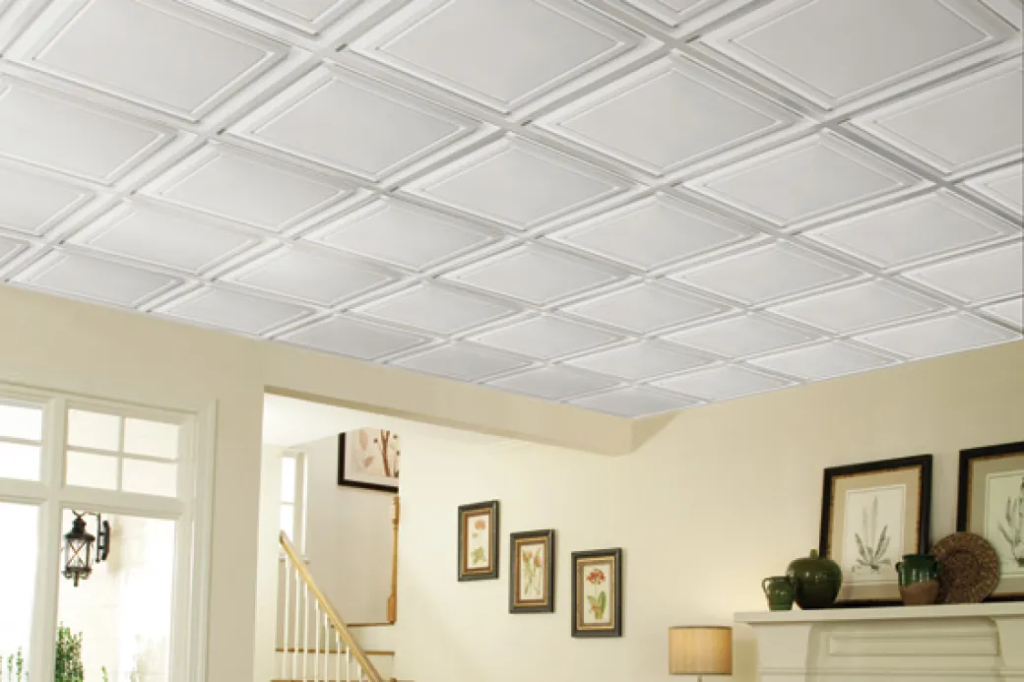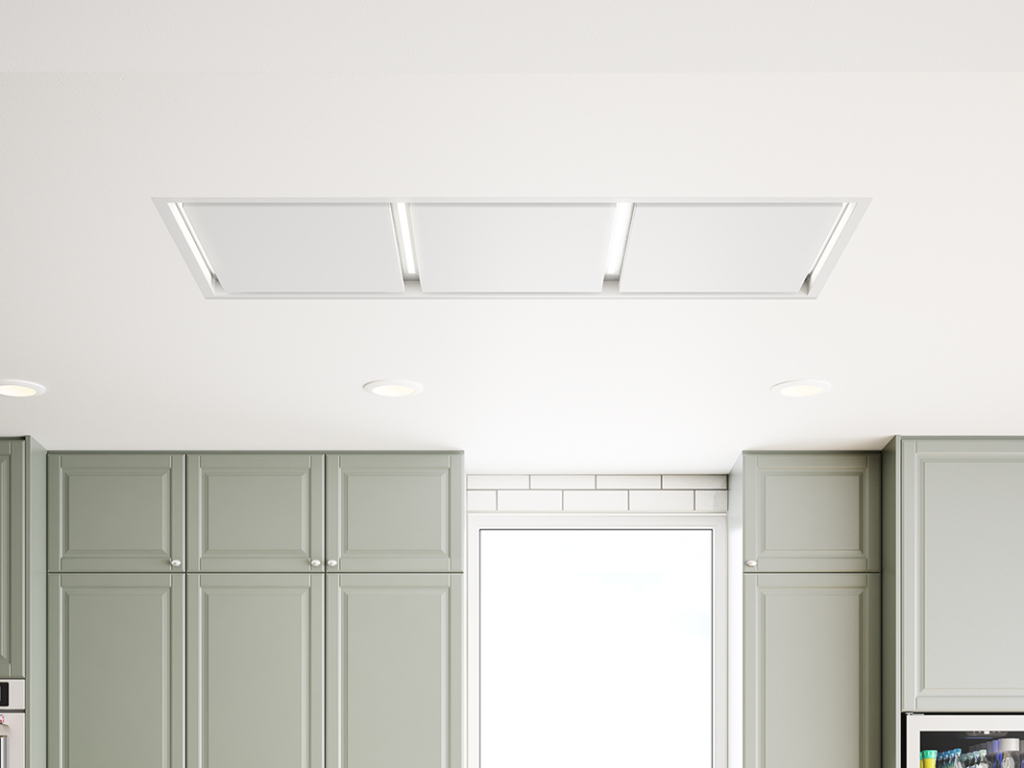When finishing a basement, one of the most important decisions you’ll make is how to handle the ceiling. Drop ceilings are a popular choice for basement remodels due to their ease of installation, versatility, and accessibility. They are an effective solution for concealing wiring, pipes, and ducts while providing a polished look. But when it comes to drop ceiling tiles for basements, choosing the right material, size, and design can make all the difference.

This guide will walk you through the advantages of drop ceiling tiles for basements, how to select the best tiles for your space, and the factors to consider for a successful installation.
Why Choose Drop Ceiling Tiles for Basements?
Basements present unique challenges for ceiling design. Since many basements contain exposed plumbing, ducts, and wiring, a drop ceiling is a practical solution to hide these elements while maintaining accessibility for future repairs. But beyond their functional advantages, drop ceiling tiles for basements also offer several aesthetic and acoustic benefits.
1. Concealing Utilities
A key reason to install drop ceiling tiles in your basement is to conceal the plumbing, electrical wiring, and HVAC ducts that are often present. With a drop ceiling, these components are hidden behind the tiles, creating a clean and organized look. Additionally, drop ceilings allow for easy access to these systems if repairs are needed, as individual tiles can be removed without disturbing the entire ceiling.
Read too: Kitchen Lighting For A Vaulted Ceiling: Illuminating Your Space with Style and Functionality
2. Moisture Resistance
Basements are often prone to high humidity, which can lead to mold and mildew. Many drop ceiling tiles are designed to resist moisture, making them a good choice for this type of environment. Moisture-resistant tiles help prevent damage and extend the life of your ceiling.
3. Sound Absorption
Basements, especially if used as a home theater, gym, or recreation room, can benefit from the soundproofing properties of drop ceiling tiles. Many tiles are made from materials that absorb sound, reducing echoes and noise transfer between rooms. If you plan to use your basement as a media room, this can significantly enhance your experience.
4. Aesthetic Versatility
Drop ceiling tiles are available in a variety of colors, textures, and finishes, allowing you to choose the perfect look for your basement. Whether you prefer a modern, sleek design or a more traditional appearance, drop ceiling tiles offer flexibility in style. You can select tiles that complement the overall design of your basement, from bright white tiles that reflect light to darker tiles that create a cozier feel.
Factors to Consider When Choosing Drop Ceiling Tiles for Basements
When selecting drop ceiling tiles for your basement, several factors come into play. It’s essential to choose tiles that meet both aesthetic and functional requirements. Here are some of the key considerations:
1. Tile Material
The material of the drop ceiling tiles plays a significant role in their performance. Popular materials include:
- Mineral Fiber: Mineral fiber tiles are highly absorbent, making them ideal for soundproofing and moisture resistance. They are often used in basements where acoustics and humidity are a concern.
- PVC (Plastic): PVC tiles are waterproof and resistant to mold and mildew, making them a good choice for wet basements. They are also available in a wide variety of styles and finishes.
- Fiberglass: Fiberglass tiles are lightweight, moisture-resistant, and durable. They also provide excellent sound absorption and are often used in areas where acoustic performance is a priority.
- Metal: For a more industrial or modern look, metal tiles are available. They are durable and moisture-resistant, though they may not offer the same acoustic benefits as fiber-based materials.
2. Tile Size
The most common sizes for drop ceiling tiles are 24 x 24 inches (2 x 2 feet) and 24 x 48 inches (2 x 4 feet). Both sizes can be used in basement spaces, but each has distinct advantages:
- 24 x 24-inch tiles: Smaller tiles create a grid pattern that offers a more detailed, intricate look. They are ideal for smaller rooms or areas where you want a more visually complex ceiling.
- 24 x 48-inch tiles: Larger tiles create a more modern, streamlined appearance. They are often used in larger basement spaces where fewer tiles are needed, and the larger format can help create a more open feel.
3. Acoustics
If your basement is being converted into a home theater, music studio, or entertainment room, soundproofing is a key consideration. Some drop ceiling tiles are designed specifically to absorb sound, reducing echoes and improving sound quality. Acoustical tiles with high NRC (Noise Reduction Coefficient) ratings are your best option for achieving optimal sound control.
4. Fire Resistance
In basements, where electrical wiring and other hazards may be present, fire-resistant drop ceiling tiles can provide added peace of mind. Many ceiling tiles come with fire-resistant coatings or are made from naturally fire-resistant materials.
5. Aesthetic Preferences
Your aesthetic preferences will play a role in choosing the right tile. Drop ceiling tiles for basements come in various colors, patterns, and textures, allowing you to customize the look of your basement. Choose from traditional white tiles, more contemporary black tiles, or textured finishes that replicate wood, stone, or even metal.
Advantages of Using Drop Ceiling Tiles for Basements
Installing drop ceiling tiles in your basement offers numerous benefits, both functional and aesthetic. Here are some of the key advantages:
1. Easy Access to Utilities
The most significant benefit of drop ceilings is the easy access to plumbing, wiring, and HVAC ducts. In a basement where these utilities are often visible, having a drop ceiling provides the ability to maintain and repair systems without the hassle of removing large sections of drywall.
2. Better Lighting
Because drop ceiling tiles are suspended below the main ceiling, they can also be used to conceal lighting fixtures like recessed lights. This creates a more polished, modern look. Additionally, the reflective surfaces of some tiles can help brighten the basement by bouncing light off the ceiling.
3. Cost-Effective Solution
Compared to traditional drywall ceilings, drop ceilings are generally more affordable to install. The tiles are inexpensive, and the installation process is straightforward, making it a cost-effective solution for basement ceiling needs.
4. Quick Installation
Installing a drop ceiling is often quicker and easier than installing drywall. Since the tiles simply drop into the grid system, it requires less labor and can be completed in less time, especially if the basement’s ceiling is relatively small.
5. Moisture Protection
Basements are notorious for their humidity and moisture problems. Many drop ceiling tiles are specifically designed to resist moisture and mold growth. If moisture does become a problem, tiles can be easily replaced without having to redo the entire ceiling.
How to Install Drop Ceiling Tiles in Your Basement
Once you’ve chosen the best drop ceiling tiles for your basement, the next step is installation. While the process may seem complex, it is relatively simple with the right tools and preparation.
Step 1: Measure the Basement Ceiling
Start by measuring the length and width of the ceiling. This will help you calculate how many tiles you need, as well as the layout of the grid system.
Step 2: Install the Grid System
The grid system is the framework that holds the drop ceiling tiles in place. Use a level to mark a reference line along the perimeter of the room. Once the reference line is set, you can install the main runners and cross tees to create the grid structure.
Step 3: Cut the Tiles
Depending on the size of your basement, you may need to cut the tiles to fit around the edges of the room or around obstacles like light fixtures or vents. Use a utility knife to make straight cuts.
Step 4: Place the Tiles
Once the grid is installed and the tiles are cut to size, simply drop the tiles into the grid. Ensure that they sit securely in place and that all seams align properly.
Step 5: Add Finishing Touches
After installing the tiles, consider adding finishing touches like lighting fixtures, crown molding, or trim to complete the look.
Conclusion
Drop ceiling tiles for basements are a practical, cost-effective, and aesthetically versatile solution for improving your basement’s appearance and functionality. By considering factors like material, tile size, acoustics, and moisture resistance, you can choose the perfect tiles for your space. Whether you’re looking to conceal utilities, improve soundproofing, or simply enhance the design of your basement, drop ceiling tiles are an excellent choice for a finished basement ceiling. With easy installation and maintenance, they offer long-lasting benefits that enhance both the look and function of your basement.


















